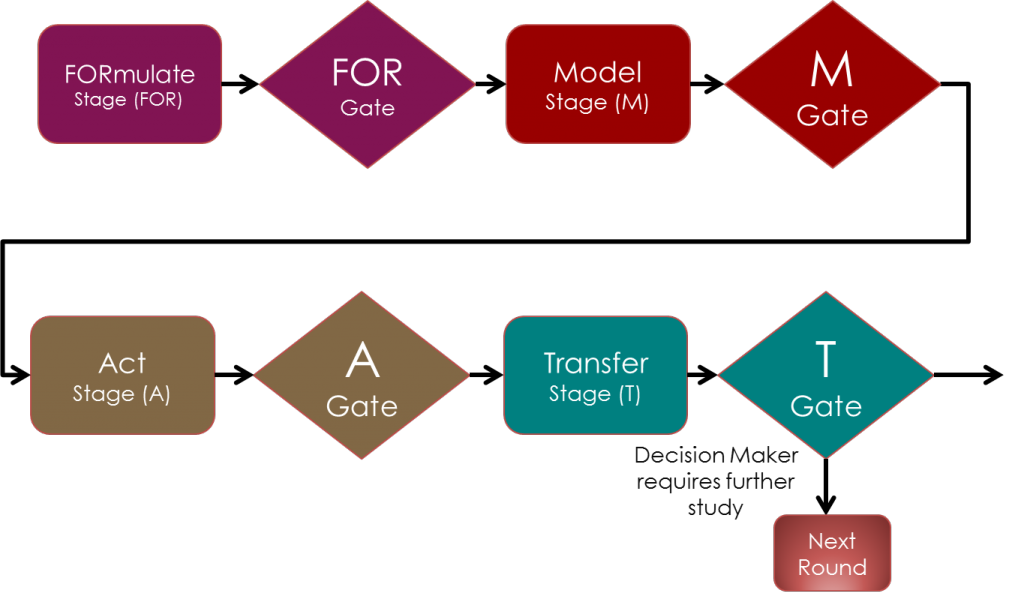FORMAT Methodology
The FORMAT methodology has been conceived as a Stage-Gate process in order to keep control over project activities with the ultimate goal of maximizing the process efficiency in terms of ratio between the forecasting project outcomes and the efforts dedicated to produce them.
The overall methodology counts four pairs of stages and gates; at the end of the final gate, the beneficiaries of the technology forecasting might ask for a second iteration of the process in order to increase the detail of the analysis or to enlarge the scope of the investigation.
Prep Time
12 working sessions
Total Time
22-28 working days
Each stage is described by means of two items, in order to give a similar internal structure to the stages. The first item is a description of the stage goal, by using a functional syntax: it allows the analysts to have a clear description of the goal to be accomplished. The analysts have to address the functional description to move on to the next stage. The second item is a more detailed check-list of duties to be addressed, so as to fulfil the main function of the stage. Then, each stage is followed by a gate, depicting the detailed requirements (in terms of information needs) that prescribe what should be checked before deciding whether to continue with the following activities of the TF project.
The following Table describes the main functions, duties and requirements for each stage-gate pair. Four stages constitute the TF process: the stages are split according to the FORMAT acronym: FORmulate, Model, Act and Transfer.
| Stage | Main Functions | Duties |
| FOR: Diagnose duties and plan project |
<prepare & make> <decision> <about forecasting project>
<define> <boundaries / resource> <of forecasting project> |
|
| M: Define the system forforecast and study contexts | <review> <existing knowledge> <about system> |
|
| A: Develop forecast for defined system and context | <identify> <a system of problems> <that drives evolution of system>
<recognize> <evolutionary trends> <for identified system>
<identify> <changes of performance characteristic in time>
<aggregate and validate> <results of qualitative and quantitative studies> <into forecast> |
|
|
T: Prepare report and present results |
<transfer> <results of study> <to decision makers> |
|
Firstly, Stage FOR is related with the motivation of the forecasting analysis. This stage has to check whether the forecast is really needed or not. Moreover, at this stage the analysts needs to agree on:
- the description of the main objectives and the expected outputs of the forecasting project;
- a clear statement about how the forecast will be applied within the decision making process;
- the possibility to satisfy the formulated needs with or without TF.
Additionally, the resources to address the forecasting project have to be defined and the activities suitably planned.
Stage M is about the definition of boundaries for the forecast and the analysis of the relevant existing knowledge about the technology or system under study. In order to address this review, the analysts have to produce:
- an AS-IS description of the technology and its context;
- a list of resources relevant for the technology;
- a description of alternative technologies (a set of) that deliver the same results. This stage should result in a complete overview of the technology and the contexts it operates in.
The activities of Stage A consider both a qualitative and a quantitative perspective to forecast the future. The qualitative approach is further detailed into a problem- and a solution-focused generation of knowledge about future. The former defines critical problems and resources that limit the technological development (e.g. by using the TRIZ concepts of contradictions and resources). The latter aims at envisioning by analogical reasoning the potential evolutions addressing both the identified problems and the lack of system resources. The quantitative approach is based on data-series analysis (e.g. by applying regression analysis as logistic growth curve).
Eventually, the T stage aims at transferring the forecasting results to the project beneficiaries. The analysts have to develop a proper knowledge flow system in order to transfer their results to beneficiaries, such as a reports, presentations, lists, posters, etc. This last stage should not be overlooked: indeed, the process of formulating a technological forecast is similar to a learning process. The difference with respect to standard learning is that the team members gain knowledge about the future, rather than about the past. This implies that the beneficiaries of a TF project, i.e. the decision makers who are supposed to use those outcomes to define strategies and plans, face the interpretation of information they did not contribute to build. Here two opposite scenarios might emerge: either the forecast is fully plausible, but in this case the advantages deriving from the TF reveal to be quite limited, or the forecast sounds unexpected. The latter case, if the TF is lately confirmed, offers the greatest advantages, but clearly proper arguments should be provided to get trusted. In turn, the T stage has the role to provide significant contents and solid arguments in a concise form.


